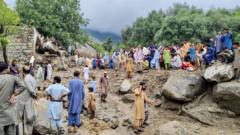At least 164 fatalities have been reported over the last day due to severe monsoon floods and landslides impacting both Pakistan and the neighboring region of Pakistan-administered Kashmir. Khyber Pakhtunkhwa, a mountainous area in northern Pakistan, recorded the majority of the losses, with disaster management authorities attributing 150 deaths to the extreme weather. The situation has worsened with the destruction of at least 30 homes and a tragic helicopter crash during rescue operations, resulting in the loss of five crew members.
In addition to casualties in Khyber Pakhtunkhwa, Pakistan-administered Kashmir reported nine deaths, while five fatalities occurred in the Gilgit-Baltistan region. With forecasts indicating persistent heavy rainfall until August 21, the government has declared several regions as disaster zones due to the imminent threat of further flooding.
Ali Amin Gadapur, the chief minister of Khyber Pakhtunkhwa, disclosed that the M-17 helicopter crash was attributed to adverse weather conditions as it attempted to navigate to Bajaur, a border area near Afghanistan. Eyewitness accounts detail crowds gathering around excavators working to clear mud and debris, amid somber scenes of mourning where families gather for funeral prayers near the sites of the deceased, many of whom are being covered with blankets.
Rescue efforts are ongoing in Indian-administered Kashmir, where nine bodies were recovered following a flood event stemming from localized heavy rains in a Himalayan village. The annual monsoon season spanning from June to September accounts for approximately three-quarters of South Asia’s yearly rainfall, often leading to floods and landslides. This monsoon season alone has resulted in over 300 fatalities across the region.
The Punjab province, which houses nearly half of Pakistan’s population of 255 million, experienced a staggering 73% increase in rainfall this July compared to the previous year, leading to more deaths than reported throughout the entire previous monsoon season. Climate experts suggest that climate change is exacerbating the frequency and severity of such extreme weather events.




















